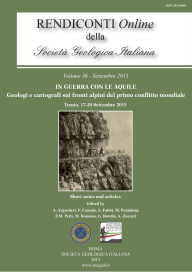
The front in high alpine rock and ice regions. World War I from an engineering geological point of view
Daniela Angetter (a) & Bernhard Hubmann (b)
(a) Institut für Neuzeit- und Zeitgeschichtsforschung. Forschungsbereich Österreichisches Biographisches Lexikon der Österreichischen Akademie der Wissenschaften, A-1030 Wien, Kegelgasse 27; Tel.: +431515812609, e-mail: daniela.angetter@oeaw.ac.at
(b) Institut für Erdwissenschaften, Universität Graz, Heinrichstraße 26, A-8010 Graz; Tel.: +433163805586, e-mail: bernhard.hubmann@uni-graz.at
DOI: https://doi.org/10.3301/ROL.2015.133
Volume: 36/2015
Pages: 10-13
Abstract
Soon after the Kingdom of Italy declared war on the Austro-Hungarian Empire in May 1915, the hostilities in the high mountains of the Southern Alps began hesitantly and at once solidified to a fierce positional war. For territorial gains, both sides proceeded to a subsurface warfare in hard rock and glacier ice (mining war). Simple mining tools (hammer and chisel), as well as increased technical equipment (drilling by means of pneumatic and electric hammers and blasting) were applied to the mutual tunneling operations (galleries, counter galleries, galleries to locate enemy tunnels and caverns). Until 1918, a total of 34 peak positions were blown up. The impact of engineering geological factors on tunnel driving and blasting success is explained by selected examples (Lagazuoi, Col di Lana and Monte Sief, Marmolada, Monte Cimone and Pasubio).
Keywords
Get Full Text